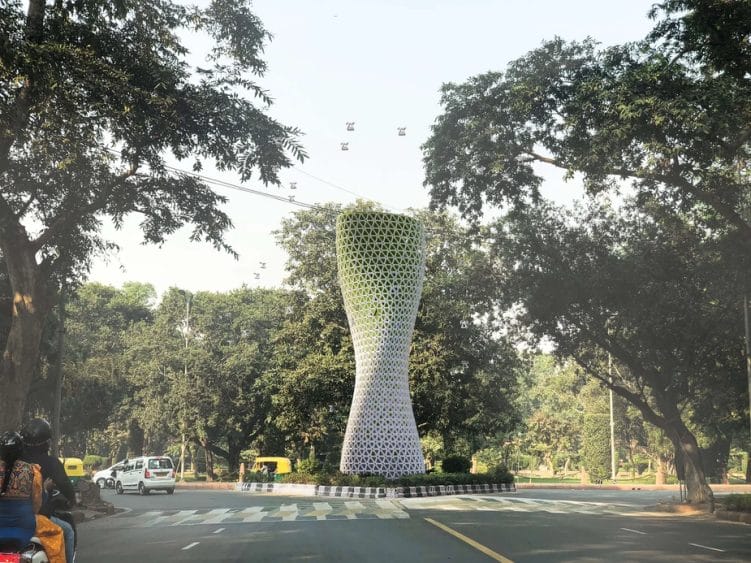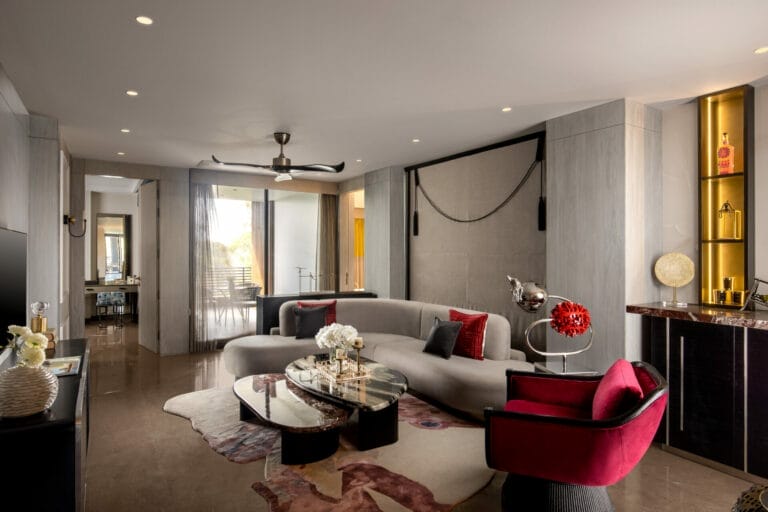The World Health Organization (WHO) has rated air quality in India’s capital of Delhi as one of the worst in the world. The fifth leading cause of death in India, air pollution is a silent killer. In response, Indian practice Studio Symbiosis Architects (SSA) has taken on a pro-bono project to design Aũra, a system of air purifiers for all residents in Delhi.
The Aũra air purifiers, which use the principles of aerodynamics and rely on a curved shape and pressure differentials to intake polluted air and produce cool, clean air.

The city of Delhi has made news repeatedly in recent years for the thick, suffocating smog that has blanketed the city and surrounding areas. With PM 2.5 levels spiking to dangerous highs, Studio Symbiosis Architects proposed a solution that could be enjoyed by all residents and not just those who could afford home air purifiers.
In order to efficiently purify the air in its surrounding neighborhood, each Aũra tower would have two rooms one for increasing the relative velocity of the air and the other for purifying the polluted air before blowing it out at high speeds and at lower temperatures to create a pressure difference that then pushes warm, polluted air back toward the tower.

Towers of this design enable the masses of clean, cold air entering at the top to exit at the top, resulting in a greater throw into the atmosphere. By way of comparison, an average adult inhales 16 cubic meters of air over the course of an eight-hour working day, whereas these towers are able to purify 30 million cubic meters each day. One tower can clean 1.115 million cubic metres of water per hour, serving half a million people.
Computer simulations for the towers’ design led to an elliptical geometry for their floor plans, which gave them a minimum resistance and maximum surface area. This was the same elliptical geometry that airplane wings used.
The tapered design of the wind channels the wind along its surface, increasing the amount of air that comes in. Due to differences in temperature and pressure between the air that comes in and goes out, a loop is created around the towers, pulling warm air toward the towers.

The towers have been designed with a triangulated structure to ease the execution of their function. The tapered surface helps catch tower wind to increase air flow. A green planter system has been provided for added oxygenation and has an integrated drip irrigation system.
The other two systems create networks of small objects moving through the city of Delhi. In response to the problem of artificially-generated wind interfering with the study of natural wind’s effects on the environment, it was designed as an attachment for cars.
Aũra Velocity, a portable air-purifying device made of aluminum and acrylic, can be installed on a car’s roof to purify the automobile’s exhaust, as well as the surrounding air. The Aũra Falcon system is a network of drone air purifiers that could fly through the city of Delhi. These drones are components of cleaning towers that detach from their stations and move around the city, guided by live updates of pollution levels. They have been fitted with cameras that double as security monitors.

Aũras are a network of people who are pro-active in defending the environment and seeking solutions to problems. They help create a clean environment for Delhi and other cities around the world.






















